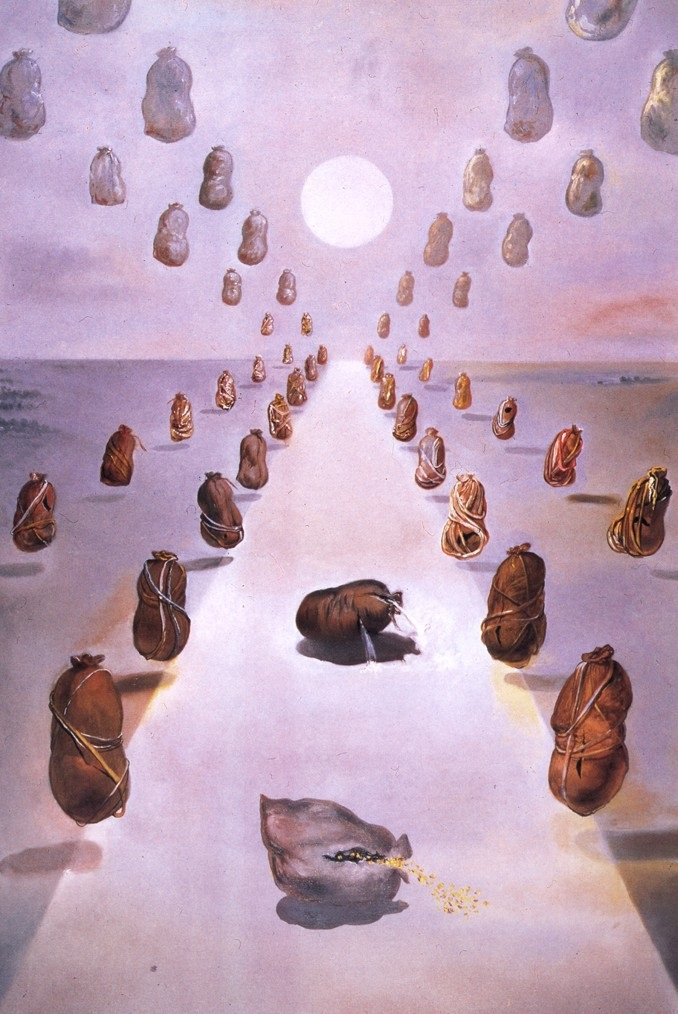log in
Enter site
Login to use Arthive functionality to the maximum
The path of the mysteries
Salvador Dali • Painting, 1981, 139×94 cm
Description of the artwork «The path of the mysteries»
Picture "The path of the riddle" - one of a series of works under the general title "The Last Role". This cycle Salvador Dali created for several decades, until his death. Due to his age, it was difficult for him to write, but it was these last works that began to be perceived by art lovers in a completely different way - the artist added even more fantasy and unusualness to his individual style. Surrealism in his work has acquired the scale of the grotesque.
The Path of the Riddle is an unusual canvas filled with deep philosophical meaning, the author's own reflections on life. All Dali's paintings are interesting because each viewer finds in them something of their own, almost intimate. However, not every layman is able to appreciate their true artistic value. Some jobs are annoying, some are under pressure. One thing only remains unchanged: the fantasies of the great Spaniard leave no one indifferent.
At the time of writing The Paths of the Riddle, Dali had acquired worldwide fame and became one of the most significant artists of the 20th century. In 1978 he held an exhibition at the Guggenheim Museum and was admitted to the Academy of Fine Arts in Paris. A year later, he organized a major retrospective at the Georges Pompidou Center in Paris and at the Tate Gallery in London. However, his works, created since the late 1970s, are not distinguished by their thoroughness. The artist, who suffered from Parkinson's disease, found it increasingly difficult to hold the brush.
In The Path of the Riddle, Dali invites the viewer to walk into an unknown distance along a path illuminated by inviting moonlight and framed by bags. According to the artist, they contain information. This iconography is widely represented in his work, especially in the painting of the early period, for example, in "Surrealistic Composition (Inaugural Goosebumps)" or in the missing painting "Honey is sweeter than blood".
The reading of this allegorical work is based on duality. On the first level, the viewer immediately sees bags of grain and wheat. On the next - more philosophical tier - it is filling with information and understanding, which is the final meaning of the work. The lines of perspective in the painting converge towards the horizon and focus on the cold celestial body. It seems that the path outward, beyond the horizon, echoes through its reflection at the top of the canvas.
It is known that Dali, creating the last picture in his earthly life, dreamed of writing another large series of canvases. In them, he wanted to portray his dreams, infinity, immortality of the soul and tangled reality, which he pondered during a serious illness at the end of his mysterious journey.
Dalí donated this painting to his Theater-Museum in honor of the presentation of the Gold Medal of the Autonomous Government of Catalonia in 1982.
The Path of the Riddle is an unusual canvas filled with deep philosophical meaning, the author's own reflections on life. All Dali's paintings are interesting because each viewer finds in them something of their own, almost intimate. However, not every layman is able to appreciate their true artistic value. Some jobs are annoying, some are under pressure. One thing only remains unchanged: the fantasies of the great Spaniard leave no one indifferent.
At the time of writing The Paths of the Riddle, Dali had acquired worldwide fame and became one of the most significant artists of the 20th century. In 1978 he held an exhibition at the Guggenheim Museum and was admitted to the Academy of Fine Arts in Paris. A year later, he organized a major retrospective at the Georges Pompidou Center in Paris and at the Tate Gallery in London. However, his works, created since the late 1970s, are not distinguished by their thoroughness. The artist, who suffered from Parkinson's disease, found it increasingly difficult to hold the brush.
In The Path of the Riddle, Dali invites the viewer to walk into an unknown distance along a path illuminated by inviting moonlight and framed by bags. According to the artist, they contain information. This iconography is widely represented in his work, especially in the painting of the early period, for example, in "Surrealistic Composition (Inaugural Goosebumps)" or in the missing painting "Honey is sweeter than blood".
The reading of this allegorical work is based on duality. On the first level, the viewer immediately sees bags of grain and wheat. On the next - more philosophical tier - it is filling with information and understanding, which is the final meaning of the work. The lines of perspective in the painting converge towards the horizon and focus on the cold celestial body. It seems that the path outward, beyond the horizon, echoes through its reflection at the top of the canvas.
It is known that Dali, creating the last picture in his earthly life, dreamed of writing another large series of canvases. In them, he wanted to portray his dreams, infinity, immortality of the soul and tangled reality, which he pondered during a serious illness at the end of his mysterious journey.
Dalí donated this painting to his Theater-Museum in honor of the presentation of the Gold Medal of the Autonomous Government of Catalonia in 1982.


